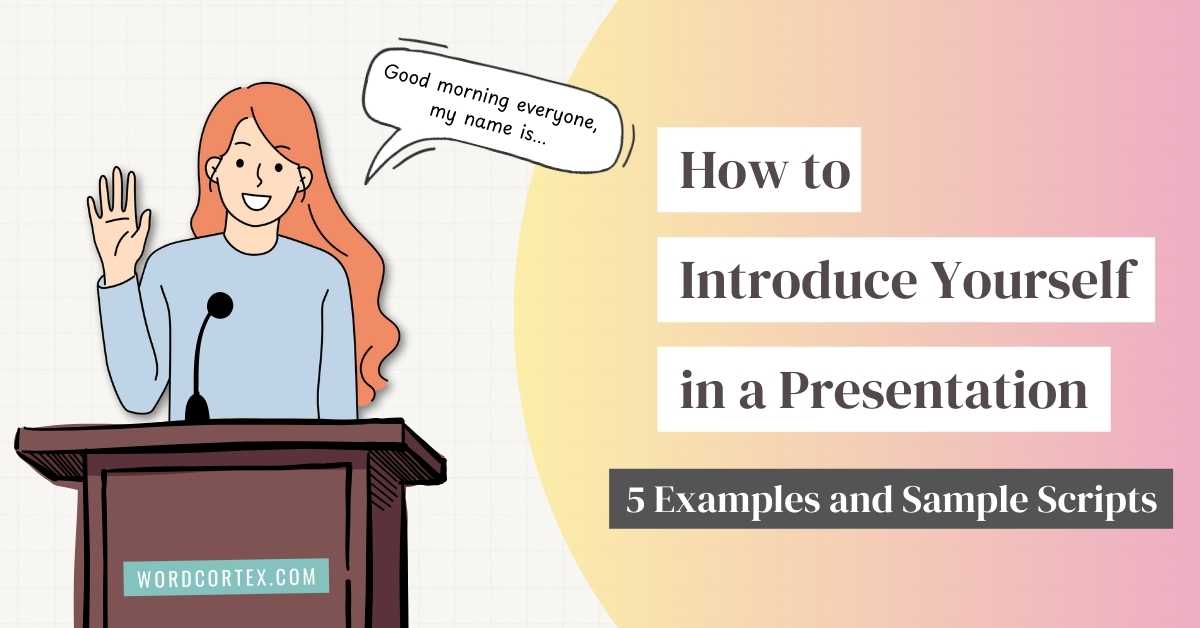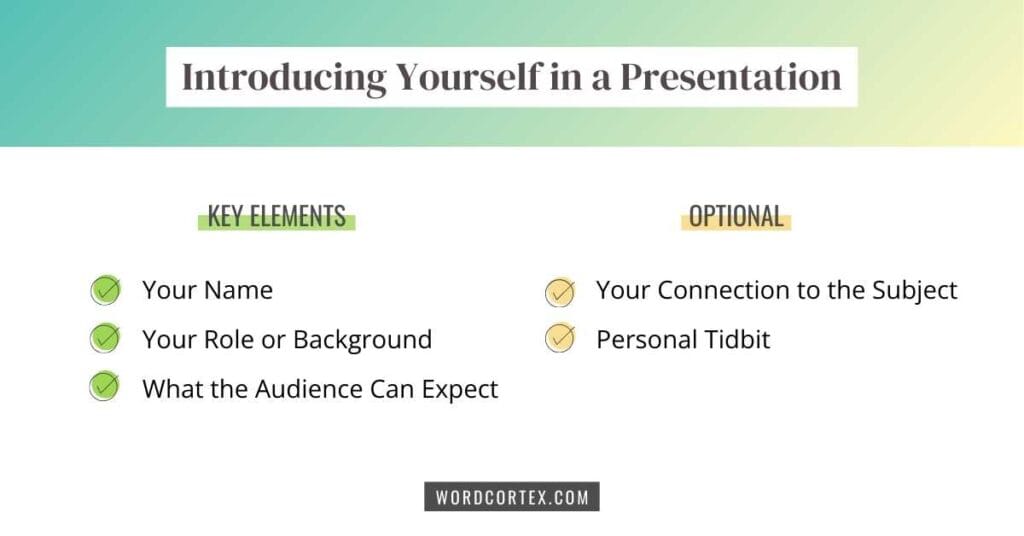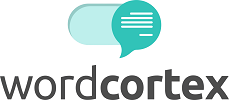How to Introduce Yourself in a Presentation: 5 Sample Scripts
Between the hours spent fine-tuning slides, what often gets ignored is the small but mighty bit: how to introduce yourself in a presentation.
A good self-introduction is like a verbal handshake with the audience. It’s short, sets the tone, and builds trust right from the start.
And yet, most of us feel uncomfortable talking about ourselves even if it’s for only a few seconds.

That’s why I’m sharing real-life self-introduction examples with you today — from basic to creative — so you can pick whatever format suits you best.
In this article, you’ll learn what makes a strong self-introduction in a presentation and how to adapt it to different scenarios, along with 5 ready-to-use sample scripts you can make your own.
Why Your Self-Introduction Matters
Your audience is already forming opinions about you…
… even before you’ve said a word.
But as the presenter, you have the power to set the tone for everything that follows.
In just a couple of sentences, you have the opportunity to build credibility and trust with your audience.
→ First Impressions Stick (Based on Science)
Research shows that it takes just seven seconds for someone to form a first impression.
That means, even before you’ve made it to your second slide, people are deciding whether or not they’re going to listen.
On top of that, the first impression (even if it’s inaccurate) tends to stick.
That’s why your introduction is your first and best opportunity to shape how you’re perceived.
→ It Establishes Credibility and Authority (Ethos)
When you introduce yourself well, it indicates that you know your stuff.
This builds ethos (or credibility) — one of the classic pillars of persuasion.
More importantly, it answers the unspoken question in every listener’s mind: “Why should I listen to you?”
How do you establish ethos or credibility in your introduction if you don’t have the experience?
At first glance, it may seem like listing years of experience shows credibility — and it certainly can — but there are other ways, too.
If you’re still developing career credentials as a student, a young professional, or pivoting careers, your passion for the topic counts.
In your introduction, tell the audience why you’re interested in the topic, what you’re studying, or how you’ve tried and tested something.
Your curiosity, initiative, and real interest go a long way in building trust — so don’t downplay them.
Key Elements of a Strong Self-Introduction
Your Name. Introduce yourself to the audience by saying your name clearly and confidently, even if the host or moderator has just introduced you.
Your Role or Background (Relevant to the Presentation). Share what you do or your connection to the topic. Pick only the bits that are relevant to the presentation topic.
What the Audience Can Expect. Give them a short one-line preview of what you’ll cover, going deeper than just the presentation title.
[Optional] Your Connection to the Subject. Share why this topic matters to you. Maybe you studied it for years. Maybe you struggled with it for years.
[Optional] Personal Tidbit. If appropriate, add a fun fact or a one-line anecdote related to the topic.

Introducing Yourself in a Speech or Presentation: Examples and Scripts
1. Basic and Simple Introduction
Sample script:
“Hi, my name is [Name], and I’m a [Role or Current Position] at [Company or Institution]. Today, I’ll be talking about [Presentation Topic].”
Corporate/Business Example:
Hi, my name is Lisa Chen, and I’m a Senior Project Manager at Acme Technologies. Today, I’ll be introducing our new digital workflow system and how it keeps all teams updated on our projects.
Academic Example:
Hi, I’m David Thompson, a Teaching Assistant in the Biology Department. Today, I’ll be showing you how to upload your assignments to our online portal.
💬 Best for a familiar audience
- Inter-departmental updates or annual meetings
- Classroom presentations
- Student seminars
2. “What You’ll Get from Me” Format Intro
Sample script:
“Hi everyone, I’m [Name], a [Role] at [Company or Institution]. Over the next [X] minutes, I’ll [Insert specific outcome].”
Corporate/Business Example:
Hi everyone, I’m Diego, the IT Manager at Acme Systems. Over the next 15 minutes, I’ll cover the 3 most common mistakes teams make when transitioning to cloud-based project tools — and how to fix them.
Academic Example:
Hi everyone, I’m Anna Mori, a research technician at the Proteomics Core. Over the next 30 minutes, I’ll be sharing the latest features of our new mass spectrometer and how you can use it for your experiments.
💬 Best for presentations that provide a specific outcome
- Training, orientation, or workshops
- Demonstrations
- Conference keynotes
3. Professional Credibility Intro
Sample script:
“Good [morning/afternoon], I’m [Name], a [Job Title] with [Years] of experience in [Field]. I’ve worked on [Key Projects/Clients/Results]. Today, I’ll be sharing [Presentation Topic].”
Corporate/Business Example:
Good afternoon, I’m Alex Malhotra, a cybersecurity consultant with over 12 years of experience in the finance sector. I’ve performed over 60 risk assessments for Fortune 500 banks. Today, I’ll be sharing 3 cybersecurity vulnerabilities that have emerged from our internal assessment.
Academic Example:
Good morning, I’m Dr. Lena Hoffman, a marine biologist at Acme University. I’ve studied coral reef ecosystems for 14 years and have contributed to 3 UNESCO reports on reef preservation. Today, I’ll be presenting a new model for predicting coral bleaching events.
💬 Best for external-facing presentations where you need to establish authority quickly
- Client meetings
- Stakeholder meetings
- Committee meetings
4. Problem-Solution Format Intro
Sample script:
I’m [Name] from [Company]. I help [Specific Audience] [Solve Specific Problem] so that [Benefit for Audience]. Today, I’ll walk you through [Solution or Process].
Corporate/Business Example:
I’m Jordan Kim from Acme Media. I help small businesses clarify their brand messaging so that they can attract the right customers. Today, I’ll walk you through our 3-step storytelling framework for web pages.
Academic Example:
I’m Dr. Sarah Min from the Center for Learning Innovation. I help K–12 educators increase student engagement so that classrooms can become active learning environments. Today, I’ll walk you through a framework for designing engaging lesson plans using cognitive science principles.
💬 Best for presentations that solve a pain point
- Training or instructional
- Marketing presentations or lead generation webinars
- Sales prospecting presentations
- Conference keynotes
5. “Fun Fact” Format Intro
Sample script:
I’m [Name], a [Title] at [Company] — and [Insert fun fact related to topic]. Today, I’ll be sharing [Presentation Topic].
Corporate/Business Example:
I’m Sara Adams, a Marketing Manager at Acme Creative — and I recently had an Instagram Reel go viral, prompting a DM from a celebrity. Today, I’ll be sharing how to use organic social media for lead generation and collaboration.
Academic Example:
I’m Rory Newman, a public health researcher at Acme Institute. I’ve been conducting field surveys on health and wellness for 4 years, and the most common answer I get is, “I don’t know, I read that online.” Today, I’ll be sharing how misinformation can impact community health education.
💬 Best for building a rapport with the audience in lighter settings
- Retreats
- Company away-days
- Smaller research conferences
- Creative industry events
- Events with a casual vibe
Adapting Your Introduction for Different Scenarios
Here are a few tweaks to make based on each scenario and its outcome.
Introducing Yourself in a Job Interview Presentation
In this context, your introduction will need to include one extra detail — positioning yourself as the right person for the job.
What to include:
- Your name
- Your background and skillset (relevant to the job you’re applying for)
- A sentence on how this presentation connects to the role
- A quick preview of what you’ll be covering in the presentation
Introducing Group Members in a Group Presentation
When presenting as part of a team, you’ll need to introduce everyone while keeping it short and smooth.
What to include:
- If applicable, a shared introduction (“Hi, we’re [Group Name or Team Name]”)
- Each member’s name, role/position, and their part in the project
- A preview of what the presentation will cover
Decide ahead of time if one person will introduce the whole team or each group member will take turns stating their name, role, and contribution to the project. Either way, rehearse the intro a couple of times to avoid confusion or awkward interruptions.
Introducing Yourself in a Classroom Presentation
Classroom settings are a bit more relaxed, but you still want to deliver a confident introduction.
What to include:
- Your name and program/year (if relevant)
- A sentence on why you chose this topic
- A quick preview of what you’ll be covering in the presentation
Introducing Yourself in a Research Seminar Presentation
In a research setting, one extra bit you might need to include in your introduction is your research focus.
Often, I’ve seen scientists stay rather broad about their research area (for example, “I study the cardiovascular system…”), but it’s always better to get specific about what exactly your work focuses on as a segue to your presentation topic (for example, “I study how cardiovascular health affects early onset dementia.”)
What to include:
- Your name and current academic/professional role
- A short line about your area of research (“I study….”)
- A quick preview of what you’ll be covering in the presentation
When Should You Introduce Yourself in a Presentation?
A common question that comes up is: Do I start by introducing myself, or should I dive right into the presentation opening first, and include my introduction after the hook?
The answer? It depends.
For most everyday presentations — project updates, team meetings, lectures, classroom presentations — it’s perfectly normal to start with a short self-introduction right at the beginning.
But in more formal or high-impact settings, like keynote speeches, product launches, or TED-style talks, it’s common to start with a strong hook — a surprising stat, a bold statement, a story — and introduce yourself after you’ve captured attention.
There’s no one-size-fits-all rule. It really depends on the tone of the event and your personal preference.
Just make sure your intro — whether it comes first or after your opening — is clear, relevant, and ties to the topic you’re presenting.
Common Mistakes to Avoid When Introducing Yourself in a Presentation
❌ Not connecting your background to the topic
You need to help the audience understand why you are the right person to be talking about this topic. Just listing your job title or degree may not be enough. Sharing a single sentence that links your role to the presentation topic is enough to make that connection.
👎 “I’m an IT consultant.”
👍 “As an IT consultant, I help small businesses recover from security breaches.”
❌ Using unfamiliar jargon
If your intro is packed with industry buzzwords that the audience has no clue about, you risk losing them before you even begin.
I have nothing against using jargon terms, provided (1) you’re among others who understand and use them, or (2) you’re able to introduce this jargon terminology to the audience by explaining it in simple words.
So, if you need to use a jargon phrase to describe your role, follow that up immediately with “What that means is…”
|
👎 Jargon-heavy self-introduction: |
“I’m an ethnographic UX researcher focused on multimodal user journey mapping.” |
|
👍 Easy-to-understand self-introduction: |
“I’m an ethnographic UX researcher. What that means is, I study how real people interact with technology in everyday life, so we can design apps that actually work the way users need them to.” |
I’d also highly recommend knowing who’s in the audience and having a general understanding of their knowledge level to prepare both your introduction and your overall presentation.
❌ Repeating what the host already said
A facilitator, host, or event moderator will likely introduce you as the speaker and welcome you on stage with applause. This means most of your credentials and experience will be shared with the audience.
Rather than saying the same thing again in your self-introduction, add something new or give a personal angle to keep it fresh.
❌ Cheesy introduction taglines
I’ve rarely seen this in academic settings, but the entrepreneurial world is rife with people trying very hard to come up with the cheesiest taglines for themselves, hoping it will stick.
From a speaker calling himself ‘The Telephone Assassin’ (phone sales trainer), to another referring to herself as ‘Real-Life Olivia Pope For the Internet’ (crisis PR), these just make everyone’s eyes roll.
I mean, it could work if someone else used that cheesy tagline to introduce them as the speaker, but it seems oddly pompous to give titles to oneself.
Now that You’ve Crafted Your Introduction, What to Do Next?
Rehearse Your Self-Introduction: Practice introducing yourself until it flows naturally. The goal here is to avoid rambling, using filler words, or showing any uncertainty or insecurity about your role.
Perform a Quick Audience Analysis: Understand who you’re speaking to and tailor your intro (and the rest of your presentation) accordingly.
Consider Adding Humor: If you like the “fun fact” or light-hearted introduction formats, you may want to learn when and how to use humor in presentations effectively.
Consider Starting Your Presentation with a Quote: A quote can be a great way to set the tone for your talk right before or after your self-introduction. Here’s a compilation of over 100 powerful quotes, categorized into topics and themes, to inspire ideas to open your talk.
Frequently Asked Questions about Self-Introduction in a Presentation
How long should my self-introduction be in a presentation?
Aim for 30 to 45 seconds — just enough to establish who you are and what the audience can expect.
Do I need to introduce myself if the host or moderator has already delivered a speech introducing me?
You can acknowledge the host’s intro speech with a thank you, and then start your presentation with a brief self-introduction. This time, you’ll highlight your connection to the topic and transition into the presentation.
What’s the best way to transition from my self-introduction into the main content of the presentation?
End your self-introduction with a one-line preview of what you’ll be covering in the presentation. (“Today, I’ll be presenting on…”) That provides a nice transition to directly get into the presentation content.
Should I present the agenda slide right after introducing myself?
Yes, that’s a good idea. Once you’ve introduced yourself and briefly summarized what you’ll cover, the audience is now ready for the next steps of the presentation.
Is it okay to use humor in my introduction?
If it feels natural to your personality and fits the tone of the event, sure, go for it! Remember to keep the humor professional and workplace appropriate.
How is introducing myself in a presentation different from introducing myself at a networking event?
In a presentation, your intro should tie directly to the topic and establish credibility. In a networking setting, it can be shorter, more informal, and focused more on making a connection.
Get actionable communication tips straight to your inbox
No fluff. Just valuable insights and practical strategies to communicate better.
We promise to keep your email address safe.
By signing up, you agree to receiving communication tips and sporadic updates from Word Cortex. You can unsubscribe anytime.






